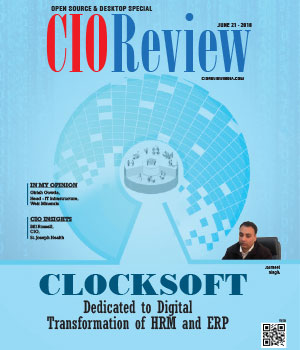
The OpenSource Innovation Revolution
Ray Estevez, CIO, V12 Group | Thursday, 07 July 2016, 09:45 IST
 Back in 2000 most Fortune 1000 companies shunned the idea of utilizing OpenSource technologies. Not that there were many commercially available products to choose from. What most technology managers didn’t realize at the time, was that the OpenSource community was in the midst of a technology innovation revolution.
Back in 2000 most Fortune 1000 companies shunned the idea of utilizing OpenSource technologies. Not that there were many commercially available products to choose from. What most technology managers didn’t realize at the time, was that the OpenSource community was in the midst of a technology innovation revolution. The first shot of this revolution was fired in 1991 by a young Finnish student named Linus Torvalds. His personal operating system project (Linux) proved to be the foundation and spark that ignited an innovation explosion. In the 24 years since the Linux kernel was introduced, there have been dozens of technologies that have changed the perception and adoption of Open Source within large U.S. businesses.
Below is a partial list of OpenSource technologies that have had a large disruptive impact:
► Linux (Operating System)
► Apache Web Server (Web Server)
► MySql &PostgreSQL (SQL Relational Database)
► PHP, Perl, & Python (Programming Languages)
► BIND (DNS Networking)
► OpenSSH & OpenSSL (Security)
► Qmail, Sendmail, & Postfix (Email Communications)
► Mozilla Firefox (Web Browser)
► Hadoop (Big Data)
► Cassandra (NoSQL Database)
► Spark (In-Memory distributed computation
engine)Businesses’ perception and adoption of Open Source has exploded over the last decade. Spurred by all the technology innovations, we now see about 86 percent of non-technical industries using open source. With the advent of the cloud-based delivery architecture and the “try-before-you-buy” model, open source business monetization is now a reality. A recent study by North Bridge highlights the incredible adoption we have seen.
► 78 percent of companies say they run operations on
open source ► 64 percent of companies participate in open
source projects
► 66 percent consider open source options before
proprietary software
► 43 percent say open source provides greater ease
of deployment
► 55 percent say open source delivers superior security
These statistics support the fact that open source has become mainstream and it is engrained in most companies. It is proving to be a smarter choice than proprietary technology packages.
This revolution has dramatically changed the landscape of technology companies. There have been a number of companies and non-open source technology casualties (Sun Microsystems, Sybase, Windows Vista, Informix, OS/2, Novell), as well as an explosion of successful startups and technologies (Google, Twitter, RedHat, Facebook, LinkedIn, MySql, Hadoop, Cloudera, and many more). Many of these successful companies share their innovations via code contribution to the community, and or by the introduction of new products and services, that fuel the global growth of the technology industry.
The technology market has rebounded to a $6 Trillion dollar industry. This capitalization is still shy of the market’s peak of nearly $8 Trillion dollars back at the height of the dot-com bubble of 2000. The biggest difference this time around is that the valuation is now based on a mature industry that is powered by great companies with sound business models. Many of these companies have leveraged the open source ideal and technologies to build and offer innovative products and services that are driving this growth. That maturity is seen by the sector’s current diversification of companies. In 1990 80 percent of the sector’s valuation was contained within 20 percent of the top technology oligarchs. Today we see only 30 percent of the valuation spread across the top 10 companies. This valuation spread makes for a healthier and more competitive industry.
Open Source now pervades in just about every innovation that the industry does from a technology perspective. It has been exhilarating to see it arrive from the periphery to the main stage of businesses of all sizes. Personally, I have embraced Open Source and have tailored most of my technology decisions around it. Many businesses are successfully implementing solutions that utilize a secure and stable operating system (Linux), incredibly powerful databases (MySQL, PostgreSQL, Hadoop), a dependable and functional web server (Apache), and flexible programming languages (PHP, Perl, Python, GCC) on new or aging inexpensive hardware to accomplish most of their technology needs. All of this while not breaking the bank.
What is next for Open Source?
Open Source has become the driving force behind the recent acceleration in technological innovations (Big Data, Internet-of-Things, OpenStack, Open Container). The introduction of these new innovations has created a boom in new “start-ups” that are being funded to incredible valuations. Some may go as far as saying that we are in the early stage of a new technology/Internet bubble. The next logical step will be an increase in consolidations among some of these young and
new companies.
The ongoing participation of thousands of independent programmers, as well as the support and involvement of large corporations, will continue to disrupt many industries and dramatically change the way we live and work today. Here are some of the new technologies to keep an eye on:
► Apache Hadoop (Cloudera, Hortonworks, IBM,
AWS, Teradata)
► Apache Cassandra (Facebook, DataStax)
► Apache Drill
► Open Container (Docker, CoreOS)
► Kubernetes (Google)
► Apache Mesos (Twitter, Airbnb, MediaCrossing)
► OpenStack (RackSpace, Red Hat, IBM, Mirantis)
► Spark (Databricks, IBM)
► Storj (Storj, DriveShare, MetaDisk)
► Internet-of-Things (Altair, OpenIoT)
► Machine Learning (Scikit-learn, Oryx, PredictionIO,
Mahout)
► Programming Languages (Ruby, GO, AngularJS, F#)
► Nginx (web server)
With all the success come some challenges. Large enterprises have expressed concerns over governance issues. The Open Source movement will need to focus on enhancing contribution policies, code approval process, and legal indemnification. There are a couple of technology frameworks like COBIT (Control Objectives for Information and Related Technologies), and ITIL (IT Infrastructure Library) that can be utilized to address some of these concerns. This will be very important in reducing security, operational and legal exposure.
My advice to everyone is to embrace the technology innovations that this movement continues to produce.
CIO Viewpoint
The OpenSource Innovation Revolution
By Ray Estevez, CIO, V12 Group
CIO's Evaluation of Implementing Software...
By Shreyas Shah, SVP-IT & CIO, Lumentum
By Ken Kauppila, CIO, Merchants Fleet Management
CXO Insights
Technology: A Positive Enabler for Businesses
By Timothy Bay, VP-Digital Marketing, Wilton Enterprises
Flash and Open Source; What Every Data Center...
By Nithya A. Ruff, Director-Open Source Strategy Office, SanDisk Corporation
Big Data, Analytics and Metrics to Make Better...







